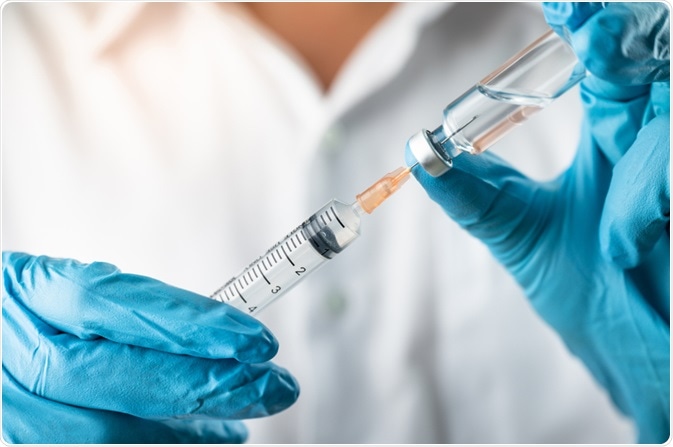There are several types of vaccines that can be used to fight diseases. Inactivated vaccines are composed of dead, or inactivated, viruses and bacteria, and therefore differ from live but attenuated vaccines.
The type of vaccine used can differ depending on the infection in question, how the immune system responds to the pathogen the vaccine will treat, and various practical considerations related to the delivery of the vaccine.
 Image Credit: PhotobyTawat/Shutterstock.com
Image Credit: PhotobyTawat/Shutterstock.com
How do inactivated vaccines work?
Many vaccines that are regularly used, such as the MMR vaccines and chickenpox vaccines, are live attenuated vaccines. These vaccines have a weakened version of the live virus, to stop it from causing the disease but to still encourage the production of T cells. Inactivated vaccines are another form of vaccine, where the virus is inactivated during the process of making the vaccine.
Inactivated vaccines are not strongly influenced by antibodies in the host body, compared to live vaccines. This means that they can be administered when antibodies are present in the blood, such as during infancy or after being given medication containing antibodies.
Inactivated vaccines cannot replicate and always require repeated doses for immunity to be achieved. The first dose is the one that prepares the immune system to respond, but a protective immune response does not develop until the second or later doses.
Because the virus is dead during the making of the vaccine, they interact with the immune system differently than live, attenuated vaccines. The immune response to live vaccines is similar to encountering the virus itself, whereas inactivated vaccines show little or no cellular immunity. This also means that inactivated vaccines can be used to boost to supplement previous vaccinations.
How are inactivated vaccines made?
To make an inactivated vaccine, the virus has to be grown in culture media. This can often be an initial limiting step in vaccine production, as producers need to understand what conditions encourage viral growth.
Inactivation of the virus is done with heat. Occasionally, inactivation is done with chemicals such as formalin. When the vaccine under production is fractional, meaning it is protein or polysaccharide-based, the vaccine undergoes further purification so that only the subunits of interest remain.
What pathogens can be treated with inactivated vaccines?
Most inactivated vaccines are available as whole-cell inactivated vaccines. These can target viruses such as polio, hepatitis A, and rabies. There are also fractional vaccines for hepatitis B, anthrax, and toxoids such as tetanus.
Several inactivated vaccines have been discontinued. Many diseases have both inactivated and activated vaccine options.
The use of inactivated vaccines, as opposed to live attenuated vaccines, is a contentious issue. For example, inactivated vaccines for influenza are currently available as subunit, rather than whole viral vaccines, in the US. Live, attenuated vaccines can, in rare cases, cause infection of the pathogen and the use of it for influenza has caused hospitalization in some children and elders. This has led to the recommendation of using inactivated vaccines, instead.
However, while inactivated vaccines have been recommended for influenza, they can have reduced efficacy when used in young children. Broader studies comparing live attenuated vaccines with inactivated vaccines have shown that live attenuated vaccines can be 18% more effective in reducing viral attack rate. Furthermore, inactivated vaccines require several infections, which can make them difficult to implement on a broad scale.
 Image Credit: Stanisic Vladimir/Shutterstock.com
Image Credit: Stanisic Vladimir/Shutterstock.com
Inactivated vaccines against COVID-19
Currently, the vaccine makers of the world are racing to create vaccines against COVID-19. Many of the companies attempting this are resorting to techniques that have been tried and tested, among which are inactivated vaccines.
Sinovac Biotech has created an inactivated whole virus particle vaccine, with an extra immune booster referred to as alum. This has been successful against SARS viruses. The Sinovac vaccine has been approved for use in China with emergency use in some other countries. Various other inactivated COVID-19 vaccines are in development, with three others at various levels of approval.
Inactivated vaccines could be advantageous in the fight against COVID-19 because they can be easily scaled up to large-scale production in many countries. However, the potential effectiveness of inactivated vaccines against COVID-19 is unknown. Current trials with an inactivated vaccine, where inactivation was done with formaldehyde and ultraviolet light, have been effectively used in a mouse model.
There are four types of COVID-19 vaccines: here’s how they work
References
- Belshe, R., Edwards, K., Vesikari, T., Black, S., Walker, R., Hultquist, M., Kemble, G., and Connor, E., 2007. Live Attenuated versus Inactivated Influenza Vaccine in Infants and Young Children. New England Journal of Medicine, 356(7), pp. 685-696.
- Centers for Disease Control and Prevention. 2020. Principles of Vaccination. [online] Available at: <https://www.cdc.gov/vaccines/pubs/pinkbook/downloads/prinvac.pdf?fbclid=IwAR1Z-PI4jhTBPYQsdbbtaS9O8M3_TfkAGiwTX4l931FImN4gTt0Kmm-GMkA> [Accessed 22 September 2020].
- Cohen, J., 2020. Vaccine designers take first shots at COVID-19. Science, 368(6486), pp. 14-16.
- Spruth, M., Kistner, O., Savidis-Dacho, H., Hitter, E., Crowe, B., Gerencer, M., Brühl, P., Grillberger, L., Reiter, M., Tauer, C., Mundt, W. and Barrett, P., 2006. A double-inactivated whole virus candidate SARS coronavirus vaccine stimulates neutralizing and protective antibody responses. Vaccine, 24(5), pp. 652-661.
- The New York Times. 2021. Coronavirus Vaccine Tracker [online] Available at https://www.nytimes.com/interactive/2020/science/coronavirus-vaccine-tracker.html [Accessed 17 March 2020]
Further Reading